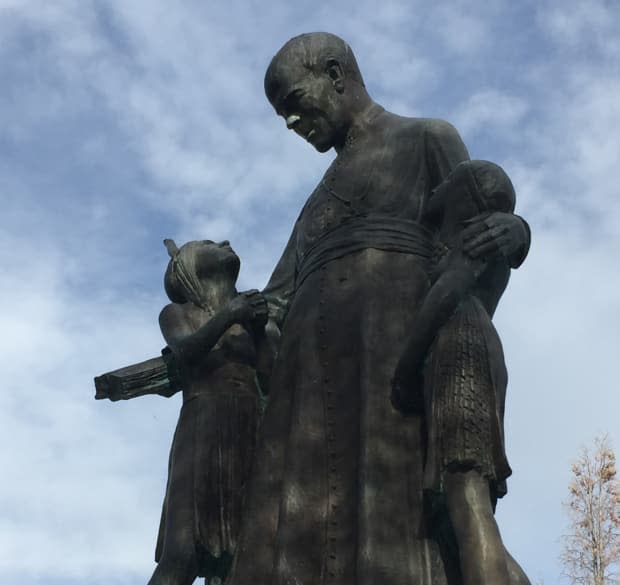Statue of residential school priest taken down in Lebret, Sask.

Calls to remove the statue of a residential school priest from a cemetery in Lebret, Sask., were successful.
The statue of Father Joseph Hugonard, a Roman Catholic priest who founded the Lebret Indian Industrial Residential School, was removed on June 21. Lebret is about 75 kilometres northeast of Regina.
The residential school opened in 1884. Before its removal the statue sat at Sacred Heart Catholic cemetery. It has been moved into storage and there are no current plans to move it elsewhere.
Star Blanket Cree Nation and the Federation of Sovereign Indigenous Nations both supported the statue's removal, but it was Star Andreas who led the call.
Andreas is a member of Peepeekisis Cree Nation and calls herself a Treaty 4 warrior woman. She camped out next to the statue for several days in protest.
Her small camp originally started out with just a kid-sized tent, but when Peepeekisis Chief Frank Dieter saw what she was doing, he came and set up a teepee.
"People came out and sat with me at the camp. They came out and donated water and food and just words of encouragement. It was amazing," Andreas said.

At one point during her stay it started to rain. Andreas said it was like happy tears from the children — residential school victims — who were happy because people were trying to find them.
She cried happy tears too.
"After they called me and told me that they're going to remove it, I was so happy. I was just in tears," she said.
Tensions are high
After speaking with Andreas and other community leaders, Archbishop Donald Bolen said he completely supported the statue's removal.
The statue depicts two Indigenous children, both wearing traditional clothing, affectionately looking up at Father Hugonard. Archbishop Bolen said that it doesn't portray the reality for kids who attended.
"I know there's a discussion about former residential schools. Should they be taken down because the memory is painful? Should they be kept up because they remind us of what happened there and they help us to tell the story today so that we learn from it?" he said.
"But I really think Indigenous voices need to be the key ones in making those decisions."

Bishop Bolen said that tensions between the Catholic Church and Indigenous people are high following the preliminary discovery of 215 children's remains at an unmarked burial site at a former residential school in Kamloops, B.C.
Removing the statue was something the diocese could act on quickly.
"Right now we're experiencing a lot of people experiencing a wave of suffering again, and it's hard to see," he said.
"I hope that some small actions that we're taking here will help us to find a way forward."
While Andreas was happy to see the statue go, she said she isn't yet ready to forgive. The intergenerational trauma of residential school still affects her. She said more work has yet to be done.
"I don't think I can forgive the people that hurt the children like that until we find them and bring them home where they belong."

 Yahoo Finance
Yahoo Finance 